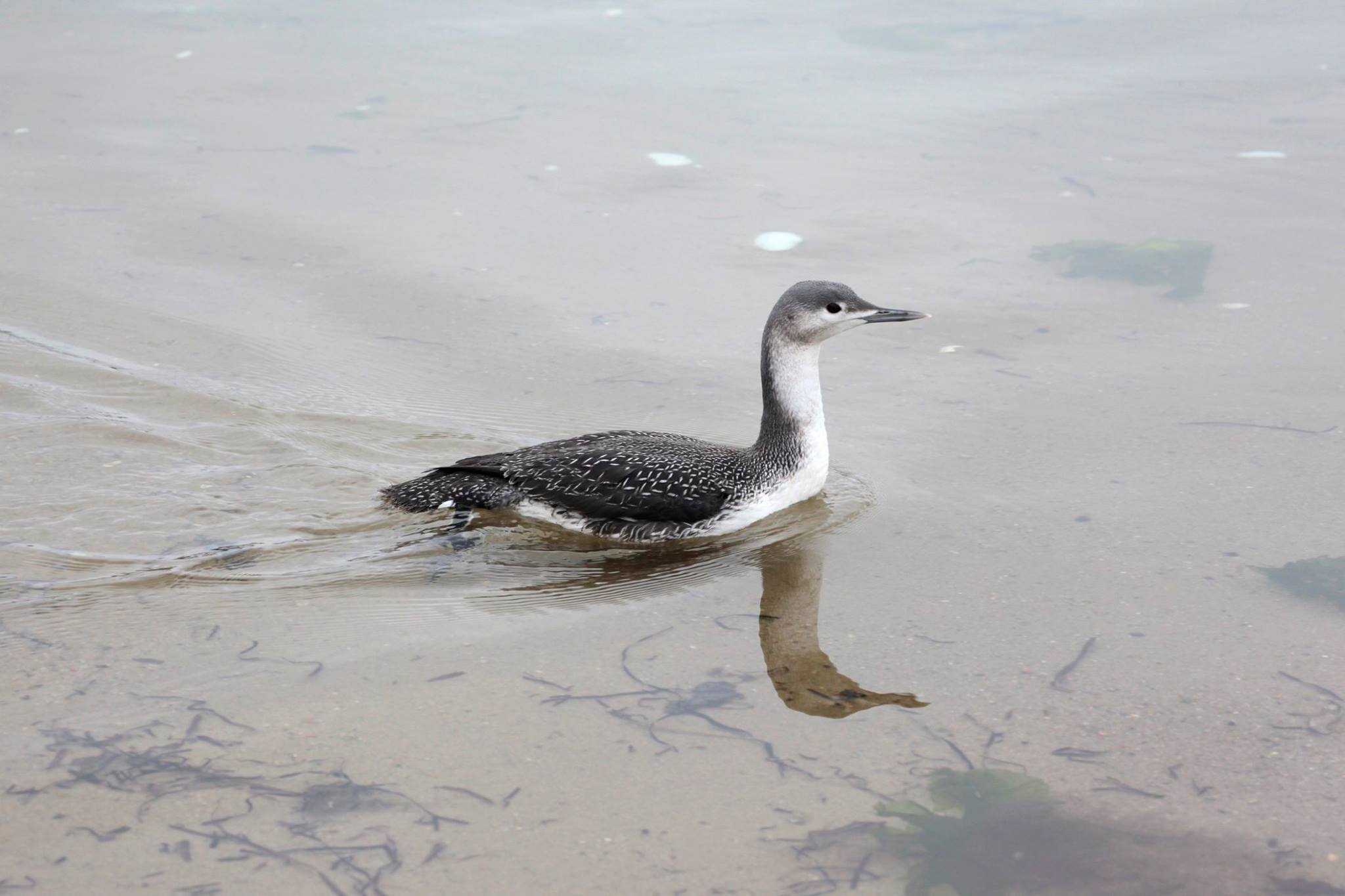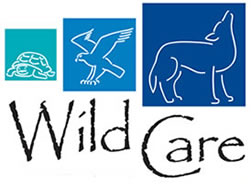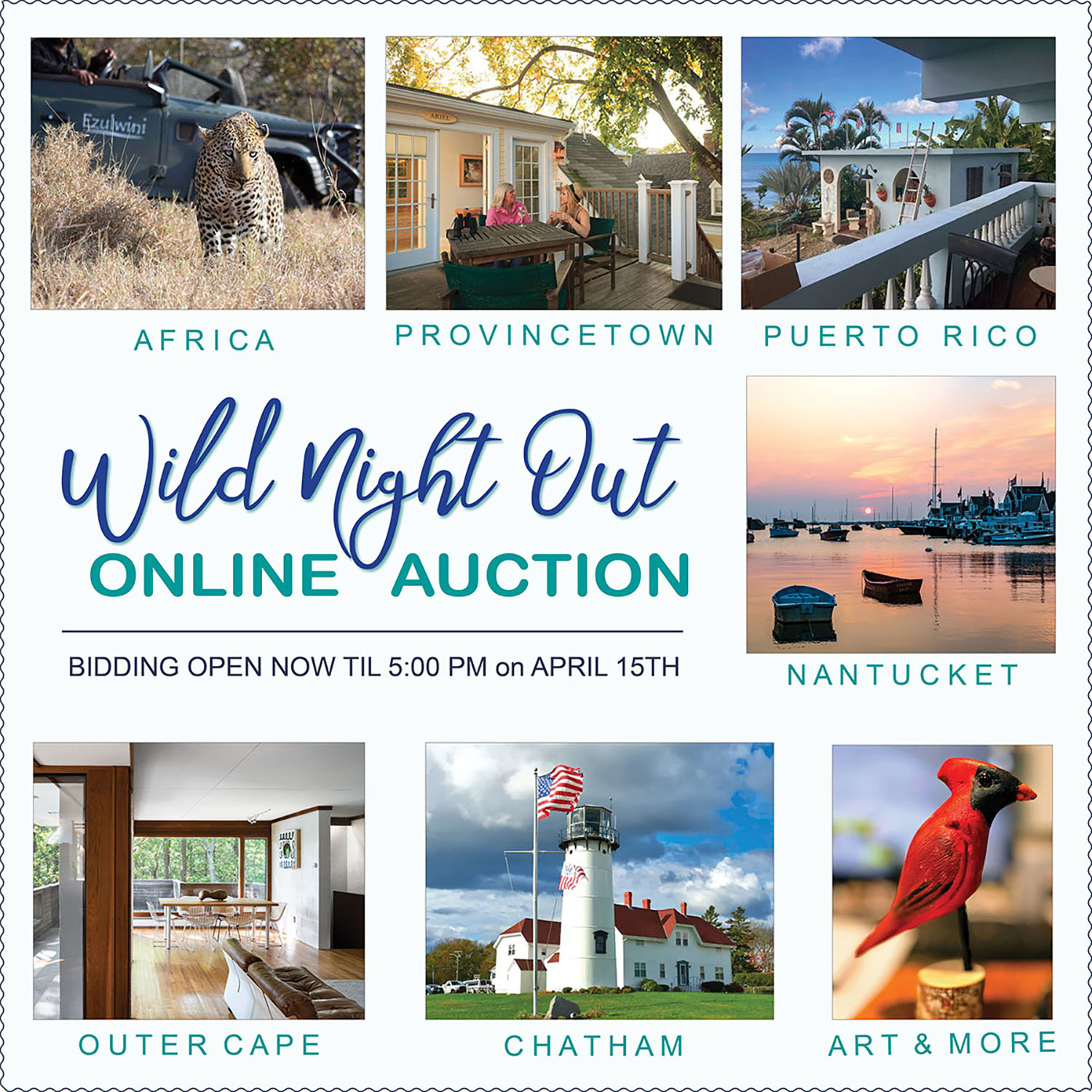
An Uncooperative Loon
Adventures of a Volunteer By Amy Sanders
It’s March 28, and I’m arriving home from a bunch of errands, when I spot the answering machine light blinking. It’s Wild Care, asking if I can get a loon in a driveway in North Truro. The call came a couple of hours ago, so I call back, hoping the Loon has been taken care of. But nope! As far as anyone knows it’s still there. So I call the original caller, who is by now extremely relieved to hear someone is coming! This forlorn loon has been in her driveway for hours.
Loon calls are fairly common. Healthy loons often strand themselves during or right after rain storms landing on pavement or in puddles thinking they are landing in water. Then they are stuck, because they can’t walk out, and need a good distance of water to get up enough speed to take off. So that is what I’m anticipating. Capture a hopefully healthy loon, get him/her checked out, and rerelease. While loons can be challenging to capture because of those long bills, it is always delightful to have an opportunity to release healthy animals.
However, the rescue of this fellow (gal maybe, but for the sake of brevity I’ll go with fellow) was to be quite challenging in many aspects. First, I had trouble finding the place (Toyota Navigation confusion required pulling over and shifting to my iPhone). As I arrived I was greeted by a woman wildly waving her arms in the driveway and there was no loon to be found. It had been 2 hours of watching him only to have him disappear in the 10 minutes between my call and my arrival.
Now, remember, loons can’t walk, and can’t take off without a span of water, so he HAS to be here, somewhere. I start my search as the woman grabs a neighbor to help. We dig in and around the brush on both sides of the driveway. Plenty of brambles, vines and poison ivy, but no loon. We look around the house—no loon. We check the road and the neighbor’s yard—no loon. Hmmm….
I’m really baffled, and being increasingly inclined to listen to the woman telling me he HAS to have flown away, despite the fact that I KNOW he can’t fly away. So, back to the search. We MUST have missed him. Sides of driveway, deeper this time, several nearby yards, up the road, roadsides, ivy beds, under cars, trucks, and even a car top carrier. No loon!
So, I’m desperately trying to figure out what’s up, when I ask the neighbor if I can go up on her patio. My brain is saying, no the loon cannot climb 5 cinder block steps to get up on a patio, since it can’t walk. But I’m desperately out of options. “Sure,” she says. The caller says what I already know. “He can’t have gotten up there if he can’t walk, right?”
“Right,” I think, but I say “We’ve looked everywhere we believe to be possible, so we have to start considering impossible.” I say this with confidence I do not actually have.
Up on the patio, there is a crawl space that goes in under the house with a door blocking it. On a long shot I decide to peek through a small space, under the house, and there several yards back in, sits one Red-throated Loon. No one can believe what I am seeing. This critter has not only dragged itself up 5 cinder block steps, but also across a concrete patio, and found a tiny crevice to pull itself in under a house.
I ask if I can go under and the owner says of course I can. But rescuing a loon is tough in the open. How am I going to crawl under a house, and while on my knees in a crawl space wrangle a loon, and secure the beak that wishes to end my life? I am still lacking confidence about this, but I’m determined!I know I will figure this out. The homeowner has generously offered to help, but because loons can be dangerous I decline.
I grabbed my trusty sheet, and crawled in. I found him calm, which was very welcome. I assume he’s utterly exhausted (this is to be a bad assumption). I wrangled him into the sheet, and backed out into the open, righted myself, and took my patient to my car to place him in my box. He provided no resistance whatsoever. I feel no broken bones, and he does not appear unduly thin, but he does seem too cold—cold and exhausted. I was able to free his beak, and snap the top on the container for the 45-minute ride to Wild Care.
Several years ago, fellow (and more experienced) rescuer, Peter, said he NEVER drove with a container that hadn’t been duct-taped closed. I forgot that wise piece of advice. I placed the container on the front seat where I have a seat heater which I turned on, and headed off with my cold and exhausted passenger. Needless to say, my avian passenger got his second wind when he got some warmth. So by the time I arrived at Wild Care, I’d been holding the top down with my right hand while my loon friend beat away at it, and driving with my left hand.
Jennifer greeted me at the deck, and I warned her. I explain how we found him, so please check under the wings for drag damage, along with everything else she assesses. Oh, by the way, he’s SUPER aggressive. I thought he was totaled but he’s regaining some of his fight. I’m wondering if he might be releasable. She says she’ll evaluate him, but he probably needs to stay for at least the afternoon.
I’m in my car getting my stuff together, waiting for my container back and answering a text when she reappears saying that this is one of the feistiest loons she’s seen, and somehow has not gotten the underside of his wings damaged in his dragging. If I’m willing to wait, she’ll finish the evaluation, and check his waterproofing. Maybe he can be released. So, I’ll wait. She heads in and emerges a couple of minutes later with one crazy uninjured maniac bird in a towel. We head down into the barn basement (where the pools are) to check the waterproofing.
This is a two-person job with this feisty fellow. He gets into the pool, quick net across the opening and he turns into an underwater missile. He’s like a rocket going round and round under the water, which Jen assures me is a good sign. Then she looks at me and says that if we don’t release him, this loon is going to end up killing himself with all this fight. Would I be willing and by the way, BE CAREFUL!
So, back into my container he went, and the top was duct taped down snugly. I headed off to release him at Pamet Harbor. He was a lively passenger the whole way. At Pamet, I put on my goggles and gloves and got ready for another go-around. I brought my spirited pal to the water’s edge, and undid the duct tape. I walked into the water to keep him from having to drag across the sand. Amazingly, as soon as that bird saw the water, he relaxed into complete calm. I tipped the box a bit more so I could slide him out. He resisted until the water touched his feet in the container and then he glided out on the water as if nothing had happened.
He didn’t even go particularly far. He just paddled around, dipping his beak in the water, and looking content. I watched from where I was as long as I could stand the cold water on my legs, and then backed out to the shore. For a few more minutes I was treated to the beautiful sight of this loon paddling around when at last he found the Pamet River current and headed off presumably to fish; diving, surfacing and then finally a long deep dive where he came up quite far away. Happy life, little one!
(Obviously there were no opportunities to photograph this forceful fellow, so the picture accompanying this is of another released Red-throated Loon, taken by Leo Seletsky).
Wild Night Out Online Auction
READY, SET, BID… We are so excited to announce that our Wild Night Out Online Auction is now live!
READ ALL NEWS
CALENDAR OF EVENTS
04 April, 2024
Wild Night Out Online Auction
EVENT DETAILS
05 April, 2024
Wild Night Out
EVENT DETAILS
28 February, 2024
Wildlife Winter/Spring Talk Series
EVENT DETAILS

DID YOU KNOW??
Wild Care has a state-of-the-art seabird therapy pool, which allows seabirds and waterfowl to exercise on running water. This will help our bird friends recover more quickly so they can get back to their watery habitats!

